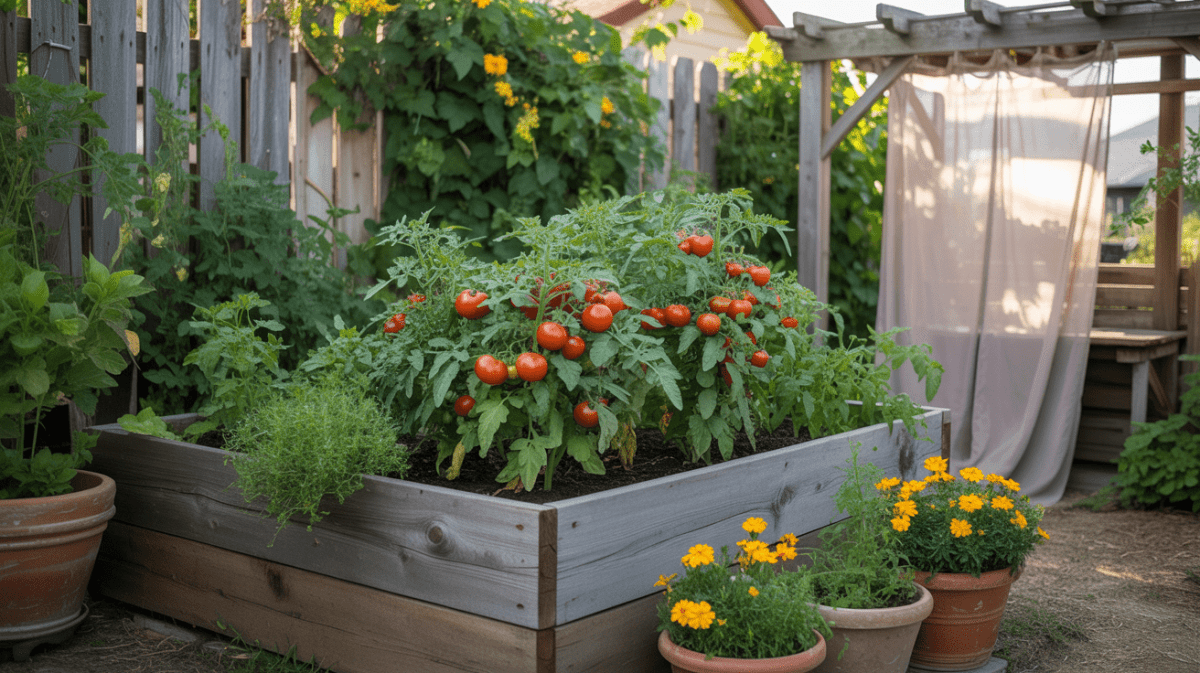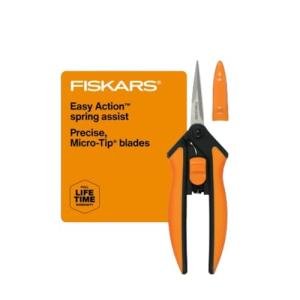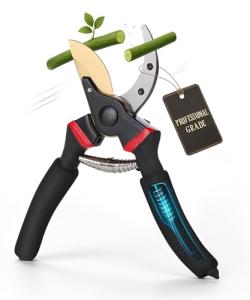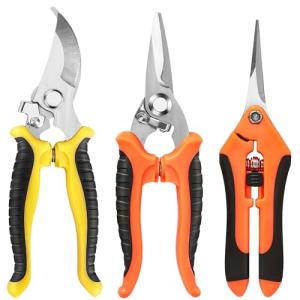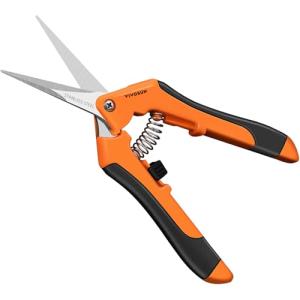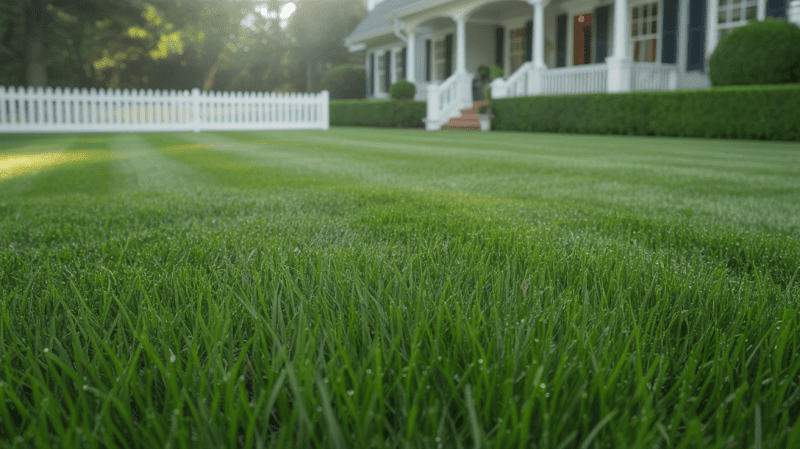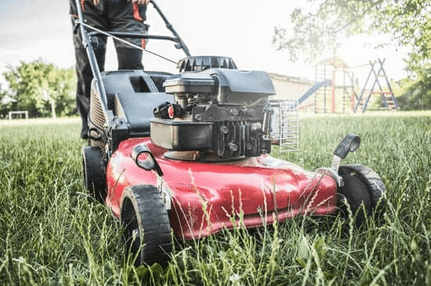Tips and Tricks for Growing Your Own Plants at Home:

I've always been drawn to growing my own garden. Raised bed gardening has made it easy for me. It's perfect for starting a garden, whether it's for veggies or flowers.
Raised bed gardening means creating a garden bed above the ground. It uses wooden frames. This method has many benefits, like better soil drainage and warmer soil.
It also makes gardening easier because you can control the soil. As a beginner gardener, this is very helpful.
This guide will show you how to start a raised bed garden. You'll learn how to enjoy the many benefits of gardening. Raised bed gardening is great for growing your own food or beautifying your outdoor space.
Key Takeaways
- Raised bed gardening is ideal for beginners due to its simplicity and flexibility.
- It offers improved soil drainage and warmer soil temperatures.
- Better accessibility is a significant advantage, reducing the need for bending or kneeling.
- You can control the soil quality and composition more effectively.
- Raised bed gardening is suitable for growing a variety of plants, including vegetables and flowers.
Why Raised Bed Gardening Is Perfect for Beginners
Raised bed gardening is great for beginners. It offers a controlled environment. This makes it easier to manage soil quality, drainage, and accessibility.
The Benefits of Starting with Raised Beds
Starting with raised beds has many advantages. It gives you better soil control and improved drainage. This method also reduces weeding and makes plants easier to reach. Better soil quality is achieved by using a mix designed for raised beds, which helps plants grow better.
A comparison of traditional gardening versus raised bed gardening is shown in the table below:
| Feature | Traditional Gardening | Raised Bed Gardening |
|---|---|---|
| Soil Quality | Variable, often poor drainage | Controlled, improved drainage |
| Weeding | More labor-intensive | Less weeding required |
| Accessibility | Often requires bending or kneeling | Elevated, easier access |
Common Misconceptions About Raised Bed Difficulty
Many beginners think raised bed gardening is complicated or expensive. But it's actually simple to set up and can be done on a budget. Choosing the right materials is crucial for a successful raised bed. I'll discuss the various options in detail later.
By understanding the benefits and dispelling common misconceptions, beginners can confidently start their raised bed gardening journey.
Understanding the Benefits of Raised Bed Gardening
https://www.youtube.com/watch?v=SMvuipMDTb4
Raised bed gardening offers many benefits, like better soil control and less upkeep. It's a popular choice for many gardeners.
Better Soil Control and Drainage
Raised beds help with better soil control and drainage. This is key for plants to grow well. I can pick the right soil mix for my plants, avoiding waterlogged soil problems.
Extended Growing Season
Raised bed gardening can extend the growing season. They warm up faster in spring, letting me start planting sooner. Plus, the drainage stops waterlogged soil issues common in traditional gardens.
Reduced Maintenance and Weeding
Raised bed gardening means less maintenance and weeding. The clear edges of raised beds help control weeds. The soil structure also means less tilling, saving me time.
Planning Your Raised Bed Garden
A well-planned raised bed garden is key to a successful gardening journey. As a beginner, it's important to think about a few things. This ensures your garden is both beautiful and productive.
Choosing the Perfect Location
Finding the right spot for your raised bed garden is crucial. Several factors need to be considered.
Sun Requirements
Most vegetables and flowers need at least 6 hours of direct sunlight a day. Make sure your raised bed gets enough sunlight.
Access to Water
Having water nearby is essential for your garden. It saves time and effort in the long run.
Proximity to Your Home
Putting your raised bed near your home makes it easier to check and care for. This increases the chance you'll take care of it regularly.
Determining the Right Size and Height
The size and height of your raised bed depend on a few things. These include the space you have and the plants you want to grow.
Ergonomic Considerations
Think about your comfort while gardening. A height that avoids bending or reaching too much is best.
Space Limitations
Look at the space you have. Narrow beds might be better for smaller areas.
Depth Requirements for Different Plants
Different plants need different root depths. Make sure your raised bed is deep enough for the plants you want to grow.
Designing Your Garden Layout
After deciding on the location and size, plan the layout. Think about companion planting and crop rotation to get the most from your garden.
By planning your raised bed garden carefully, you're setting yourself up for success. A well-designed garden looks great and is easier to maintain.
Materials for Building Raised Beds
Choosing the right materials for raised beds is key to a healthy garden. The right materials make your garden last longer and look great.
Wood Options and Considerations
Wood is a favorite for raised beds because it looks and feels natural. But, not all wood is the same. You must think about how long it lasts, its price, and its impact on the environment.
Cedar vs. Pine vs. Treated Lumber
Cedar is great for raised beds because it fights off rot and bugs well. Pine is another choice, but it needs more care. Treated lumber is cheaper but has environmental downsides because of the chemicals used.
Longevity and Cost Comparisons
Cedar lasts the longest but costs the most. Pine is cheaper but doesn't last as long. Treated lumber is in the middle on both counts.
Environmental Considerations
For those worried about the environment, think about using wood that's been sustainably harvested. Or, look into recycled plastic lumber as an alternative.
Alternative Materials (Stone, Metal, Composite)
Wood isn't for everyone. Stone and brick beds are strong and look good but are pricey. Metal beds are modern and strong but can get too hot. Composite materials are durable and easy to care for.
- Stone/Brick: Durable, aesthetically pleasing, but expensive.
- Metal: Modern look, durable, but can get hot.
- Composite: Durable, low maintenance, and versatile.
Tools and Supplies You'll Need
No matter what you choose, you'll need basic tools and supplies. You'll need a saw, drill, hammer, and screws or nails. If you pick wood, adding a protective finish can help it last longer.
- Saw
- Drill
- Hammer
- Screws or nails
- Protective finish (optional)
Step-by-Step Guide to Building Your First Raised Bed
Starting your raised bed gardening journey is easy. Just follow a few simple steps. You'll create a beautiful garden that will give you a lot of food.
Preparing the Site
Before you start building your raised bed, prepare the site. This involves several key steps.
Removing Grass and Weeds
First, clear the area of grass and weeds. Use a shovel or garden fork to remove the top layer. Or, apply a natural herbicide to kill the vegetation.
Leveling the Ground
Make sure the ground is level. This prevents your raised bed from being uneven. Use a spirit level and adjust as needed.
Laying Weed Barrier
To stop weeds from growing up into your raised bed, lay down a weed barrier fabric. This will save you time in the long run.
Constructing the Frame
With the site prepared, you can now build the frame of your raised bed.
Assembly Instructions
- Follow the manufacturer's instructions to assemble the frame. Or, use your own design if you're building from scratch.
Securing Corners
- Make sure the corners are securely fastened. Use corner brackets or screws.
Adding Bottom Support (if needed)
- If your raised bed is large or deep, add bottom support. This prevents the sides from bowing out.
Installing Optional Features
To make your raised bed better, add some optional features.
Irrigation Systems
- Installing an irrigation system saves time. It ensures your plants get the right water.
Trellises and Supports
- Add trellises or supports for climbing plants. This includes peas, beans, or tomatoes.
Pest Protection
- Consider adding pest protection like copper tape or mesh. This deters slugs and snails.
Creating the Perfect Soil Mix for Raised Beds

A well-balanced soil mix is key to a successful raised bed garden. The right mix can make all the difference. It can turn a struggling garden into a thriving one.
Understanding Soil Components
To make a great soil mix, you need to know what it's made of. Soil has sand, silt, clay, organic matter, and more. Understanding each part helps you create a mix that your plants will love.
My Recommended Soil Recipe for Beginners
If you're new to raised bed gardening, start with a simple recipe. It should have a mix of base ingredients, organic matter, and fertilizers.
Base Components
The base of your mix should have topsoil, compost, and perlite or vermiculite. These help with drainage and structure. A good mix is 40% topsoil, 30% compost, and 30% perlite or vermiculite.
Organic Matter Additions
Adding organic matter like manure or compost boosts fertility and structure. Here, you can customize the mix for your plants.
Fertilizers and Amendments
You might need to add fertilizers or amendments based on your plants' needs. This could include balanced fertilizers, lime, or other nutrients.
Adjusting Soil for Specific Plants
Each plant has its own soil needs. For example, veggies might need more nutrients than herbs. Adjusting your mix for your plants ensures they thrive. Do your research to make the right changes.
Beginner's Guide to Raised Bed Gardening: Planting Strategies
Exploring raised bed gardening, I found that smart planting strategies are key to a great harvest. Raised beds help you grow more with less effort. They make gardening easier and more rewarding.
Let's look at some key strategies for your raised bed. We'll cover companion planting, square foot gardening, and succession planting. These methods will help your garden thrive and produce well.
Companion Planting Basics
Companion planting means growing different plants together to help each other. It can improve taste, keep pests away, and even make soil better. For instance, marigolds with tomatoes can fight nematodes, and basil can make tomatoes taste better.
Square Foot Gardening Method
The square foot method divides your bed into 1x1 foot squares. Each square grows a different crop. This method uses space well and is great for growing many types of plants in a small area.
| Section | Crop | Spacing |
|---|---|---|
| 1 | Tomatoes | 2 plants |
| 2 | Lettuce | 4 plants |
| 3 | Carrots | 12 plants |
Succession Planting for Continuous Harvests
Succession planting means planting seeds often to keep harvesting all season. It's perfect for quick-growing crops like lettuce and beans.
Spring to Summer Transitions
When spring turns to summer, switch cool-season crops to warm-season ones. Swap spinach for tomatoes or peppers.
Summer to Fall Transitions
In late summer, plant cool-season crops again. Try broccoli, kale, or carrots for a fall harvest.
Winter Gardening Options
In many places, you can garden all year, even in winter. Plant hardy crops like kale and spinach for a winter harvest.
Using these strategies in your raised bed gardening will make your garden more productive and diverse all year.
Best Plants for Beginner Raised Bed Gardeners

Choosing the right plants is key to a successful raised bed garden. As a beginner, pick plants that are easy to grow and care for. This will help you enjoy a bountiful harvest and a positive gardening experience.
Easy-to-Grow Vegetables
Vegetables are essential in any garden, and raised beds are perfect for growing them. Here are some easy-to-grow options:
Leafy Greens
Leafy greens like lettuce, spinach, and kale are perfect for beginners. They grow quickly and can be ready to eat in just 20 days. "Lettuce is a great choice because it's simple to care for and can be grown in a variety of conditions."
Root Vegetables
Root vegetables such as carrots, radishes, and beets are also great. They require little care and can be ready in about 60 days.
Tomatoes and Peppers
Tomatoes and peppers are popular in raised bed gardens. They're easy to care for and can produce a lot of food with the right care. As gardening expert says,
"Tomatoes are one of the most rewarding plants to grow in a raised bed garden."
Herbs That Thrive in Raised Beds
Herbs like basil, cilantro, and parsley add flavor and fragrance to your garden. They're easy to grow and attract pollinators, helping with pest control.
Flowers for Pollinators and Pest Control
Adding flowers to your garden makes it more beautiful and functional. Flowers like marigolds, nasturtiums, and sunflowers attract pollinators and keep pests away. For example, marigolds repel nematodes, whiteflies, and other pests, making them a great choice for your garden.
By using these plants in your raised bed garden, you'll create a thriving and diverse space.
Troubleshooting Common Raised Bed Challenges
Even with careful planning, raised bed gardens can sometimes face problems. These include pests, drainage issues, and nutrient deficiencies. Knowing how to address these challenges can greatly improve your garden's health and productivity.
Dealing with Pests Naturally
Pests can be a big problem in raised bed gardens. To manage them, consider introducing beneficial insects like ladybugs or lacewings. These insects prey on common garden pests. You can also use physical barriers, such as fine mesh or row covers, to protect your plants.
Maintaining healthy soil and plants is also key. Proper nutrition and watering help them resist pest damage.
- Use companion planting to deter pests
- Apply organic pest control methods
- Encourage beneficial insects
Solving Drainage Issues
Drainage problems can cause waterlogged soil and root rot. To improve drainage, make sure your raised bed is deep and filled with a well-draining mix. Adding organic matter like compost can also help.
If water collects on the surface, consider installing a French drain. Or adjust the bed's layout to improve flow.
Addressing Nutrient Deficiencies
Nutrient deficiencies can cause stunted growth, discoloration, or poor fruiting. Regular soil testing can help identify these issues. To address them, amend your soil with appropriate fertilizers or organic matter.
For example, adding compost can improve soil fertility. Specific nutrient deficiencies may need targeted amendments.
Key steps to address nutrient deficiencies:
- Conduct regular soil tests
- Amend soil based on test results
- Use organic fertilizers when possible
Seasonal Maintenance of Your Raised Bed Garden
To keep your raised bed garden thriving, knowing the seasonal tasks is key. These tasks change with the seasons. They help your garden stay healthy and productive all year.
Spring Preparation
Spring is crucial for getting your garden ready for growth. Begin by removing winter debris. Remove any dead plants and add fresh compost to the soil. Also, check the soil pH and adjust it for your upcoming plants.
Summer Care Routines
In summer, your garden needs regular care to keep thriving. This includes consistent watering, controlling weeds, and watching for pests. It's also a great time to harvest your crops.
Fall and Winter Management
As fall comes, prepare your garden for winter. Clean up, add organic matter, and consider planting cover crops. In winter, plan for next season and fix any raised bed issues.
| Season | Key Tasks |
|---|---|
| Spring | Clear debris, add compost, check soil pH |
| Summer | Water consistently, control weeds, monitor pests |
| Fall/Winter | Clean up, add organic matter, plan for next season |
Conclusion: Growing Success with Your Raised Bed Garden
Raised bed gardening is a rewarding journey for beginners. It offers many benefits that make gardening a joy. With the right planning and care, your garden can be very productive.
By following this guide, you've started your gardening journey. You've learned how to choose the best location and create the perfect soil. Every decision is important for your garden's health and success.
The benefits of raised bed gardening are clear. You get better soil control, less maintenance, and improved drainage. As you care for your garden, you'll see your plants grow and thrive. With each season, you'll become more confident and your garden will flourish.
Remember to stay curious and keep learning. Raised bed gardening is a journey with always something new to learn. By doing so, you'll achieve gardening success and enjoy its many rewards.
FAQ
Q: What is raised bed gardening, and how does it differ from traditional gardening?
A: Raised bed gardening means growing plants in beds that are higher than the ground. These beds are often made of wood, stone, or composite materials. They are filled with a mix of soil, compost, and other amendments. This method is different from traditional gardening, where plants are grown directly in the ground. Raised beds offer better drainage, warmer soil, and are easier to access.
Q: What are the benefits of using raised beds for gardening?
A: Raised beds have many advantages. They improve soil quality and drainage. They also reduce weeding and maintenance. Plus, they are easier for gardeners with mobility issues to use. Raised beds let you plant earlier in the spring and grow longer into the fall.
Q: How do I choose the right location for my raised bed garden?
A: When picking a spot for your raised bed garden, think about sunlight, wind direction, and water access. Most plants need at least six hours of direct sunlight a day. So, pick a spot that gets enough sunlight.
Q: What materials can I use to build raised beds, and which is the most recommended?
A: You can build raised beds with wood (like cedar, pine, or recycled pallets), stone, metal, or composite materials. Cedar is a favorite because it lasts long and resists rot and insects.
Q: How do I create a well-balanced soil mix for my raised bed garden?
A: A good soil mix for raised beds has topsoil, compost, and other additives like peat moss or perlite. A simple recipe is to mix equal parts of topsoil, compost, and peat moss or coconut coir.
Q: What are some effective planting strategies for raised bed gardens?
A: Good planting strategies for raised beds include companion planting, square foot gardening, and succession planting. These methods help use space well, fight pests and diseases, and ensure you have a steady harvest all season.
Q: How do I maintain my raised bed garden throughout the seasons?
A: To keep your raised bed garden in shape, do seasonal tasks. In the spring, clean up debris and add new compost. In the summer, water and weed regularly. In the fall and winter, clean up and protect plants from frost.
Q: What are some common challenges faced by raised bed gardeners, and how can I address them?
A: Raised bed gardeners often face pests, drainage problems, and nutrient shortages. To solve these, use natural pest control, add organic matter for better drainage, and adjust your soil mix to meet plant needs.
Q: Can I grow a variety of plants in my raised bed garden, including vegetables, herbs, and flowers?
A: Yes, raised bed gardens are great for growing many types of plants. You can grow vegetables, herbs, and flowers. Just choose plants that fit your climate and the conditions of your raised bed.
Q: How can I extend the growing season in my raised bed garden?
A: To make your growing season longer, use cold frames, row covers, or hoop houses to protect plants from frost and bad weather. You can also pick varieties that do well in cooler or warmer temperatures.
DISCLAIMER
This document is provided for general information purposes only and should not be relied upon as providing legal advice, technical, or specific operational guidance to the reader, whether as to the practices described in the document or the applicable legal requirements and regulations. Lawnfly.com expressly disclaims any responsibility for liability arising from or related to the use or misuse of any information in this document.
